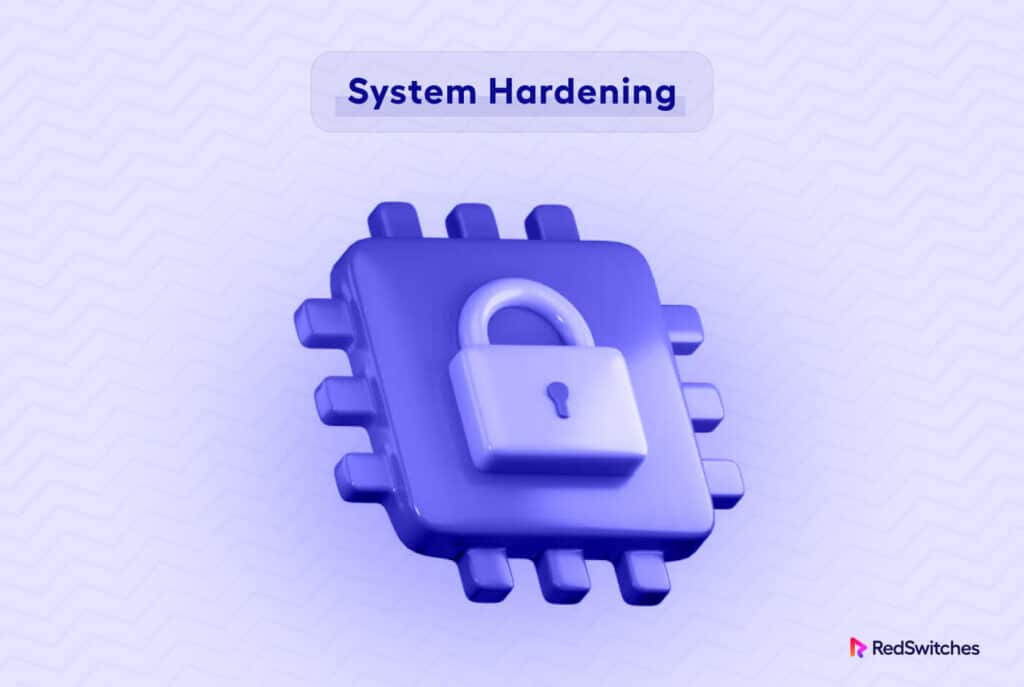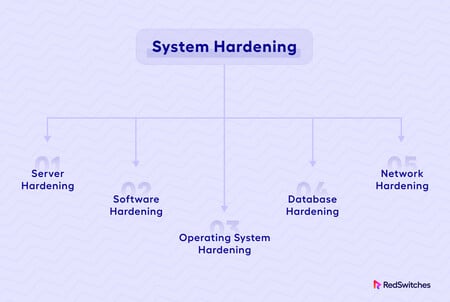The IT infrastructure of a business is usually distributed across servers running multiple services.
Security remains a critical concern for the business’s ICT teams because the exposed attack surface requires continuous investment in attention and resources for ongoing protection.
That’s where the idea of system hardening comes into play.
System hardening is an umbrella term that covers essential security best practices such as blocking unused ports, enforcing strong password standards, performing routine system maintenance, and setting firewalls to allow whitelisted traffic only.
In almost all cases, system hardening practices such as server-wide encryption and limiting administrator privileges strengthen the infrastructure’s defenses against potential attacks, protect sensitive data, and restrict unauthorized access.
In this article, we will explore the idea of system hardening, its benefits, and a suggested process you can follow to harden the security of your infrastructure.
Table Of Contents
- What is System Hardening?
- Types of System Hardening
- System Hardening Standards
- Benefits of Following System Hardening Standards
- The System Hardening Process
- Conclusion
- FAQs
What is System Hardening?
System hardening is the collection of steps and processes that increase a system’s security by minimizing the exposed attack surface of the infrastructure. This process aims to improve reliability and security to ensure smooth business operations.
The process starts with a review of the existing infrastructure and the security processes in place. Next, the admins identify the security loopholes and “weak spots” in the security protocols. Finally, the admins start hardening the security by following the best practices for securing ICT infrastructure.
The Significance of System Hardening
The core idea behind system hardening is to minimize or eliminate the impact of cyber threats through the ongoing application of industry-standard preventative measures.
Cyber threats have multiplied in sophistication over the past few years. Cybercriminals constantly look for ways to breach networks and servers to steal valuable information, interfere with ongoing business activities, or use compromised infrastructure components to launch further attacks.
System hardening is a proactive strategy to reduce these risks by minimizing how hackers can access and attack the infrastructure components. In practical terms, system hardening strengthens and supplements other cybersecurity practices, resulting in several layers of defense consisting of firewalls, intrusion detection systems, and antivirus software.
Types of System Hardening
Unlike the popular perception, system hardening is not a single process you can apply once to your infrastructure.
In fact, system hardening is a collective term for several processes applied at various infrastructure layers. The idea is to strengthen individual layers so that the collective impact of these processes enhances the collective security of all the infrastructure components.
Let’s discuss the three layers where the security processes are applied.
1) Server Hardening
The goal of server hardening is to protect a server’s ports, data, access rights, and installed features. Typical server hardening techniques include using strong passwords, locking user accounts after a predetermined number of unsuccessful login attempts, implementing multi-factor authentication, and turning off USB ports.
2) Operating System Hardening
The process of securing a system’s operating system is called operating system hardening. The exact set of operations can differ from server to server because servers in a network could have different operating systems. However, standard processes that could be applied regardless of the active OS include limiting access to critical OS processes and removing/uninstalling superfluous device drivers.
3) Software Application Hardening
The main focus of software application hardening is the protection of the installed apps on the server. The recommended processes include using antivirus, spyware, and malware protection software, properly configuring IDS, and following the best code-writing practices for custom-developed software for your business.
System Hardening Standards
Over the years, many authorities have developed standards that codify the processes and ensure that businesses have a “checklist” of steps to comply with industry standards.
We’ll discuss the three standards that help businesses follow accepted system-hardening practices.
1) CIS Benchmarks
The CIS Benchmarks are recommendations and recommended practices for securely setting up different operating systems, software, and network devices. These benchmarks were created by the Centre for Internet Security and are frequently updated by the community of cybersecurity experts.
2) NIST SP 800-53
NIST Special Publication 800-53 offers a complete list of security measures and related US federal information systems guidelines. It covers various security measures, including system and communications protection, user and process identification and authentication, audit and accountability, and access control.
3) DISA STIGs
DISA STIGs ((Defense Information Systems Agency Security Technical Implementation Guides) are security recommendations created by the Defence Information Systems Agency for protecting software and computer systems.
Benefits of Following System Hardening Standards
Now, you must be wondering why you should invest time and resources in following one of the above standards. Here are five benefits you will get out of applying these standards.
Smaller Attack Surface
System hardening standards focus on securing or disabling unused services, ports, and configurations. These steps directly reduce the possible points of entry/execution for cyber attacks.
Increased Security Posture
System hardening techniques result in a measurable improvement in an organization’s overall security posture. When applied properly, you can be sure that all systems are set up securely, and the infrastructure becomes resilient to possible attacks.
Security from Known Vulnerabilities
System hardening standards call for quick application of security upgrades and fixes. This lessens the chance of hackers exploiting known vulnerabilities in operating systems, applications, and devices.
Regulation and Framework Compliance
Numerous system hardening guidelines help increase compliance with industrial regulations and cybersecurity frameworks. This increased compliance with these standards helps organizations avoid legal issues stemming from regulatory violations.
Protection Against Emerging Threats
Organizations can better protect themselves against emerging cyber threats and attack vectors by updating their security standards. This significantly reduces the risk of emerging attack vectors using existing vulnerabilities to compromise your system.
The System Hardening Process
Now that you understand the importance of system hardening and its contribution to securing your business operations, let’s go through a typical process you can apply to secure your infrastructure.
Phase No 1: Assessment and Risk Analysis
The first phase covers the initial system assessment and building a risk analysis profile.
At this point, the most critical activity is identifying risks associated with the attack surface. The assessment process may include vulnerability scanning, penetration testing, and security audits to understand the existing security posture and potential threats to the infrastructure.
The findings of this phase are used throughout the rest of the process.
Phase No 2: Planning and Policy Development
In this phase, the IT teams create a set of policies and an action plan(s) based on the findings of the previous phase.
The teams ensure the plan complies with the security standards, policy recommendations, and legal and industry best practices.
The outcome of this phase is a framework for setting up and enhancing specific security measures across the organization.
Phase No 3: Configuration and Patch Management
From this phase onwards, the IT teams start the implementation of the framework developed in the previous phase.
During this phase, the implementation process starts with the teams adding security configurations and settings to the network devices and operating systems.
The list can include turning off unused services, turning on security features, and setting up access controls. During this phase, the teams regularly maintain operating systems, apps, and firmware by applying the most recent security updates.
Phase No 4: Access Control and Authentication
The principle of least privilege holds that a user should only have access to the processes and features that are absolutely essential for their work.
The IT teams apply multiple control mechanisms to limit user access and privileges. Strong authentication procedures are also deployed to guarantee that only authorized users can access crucial resources such as multi-factor authentication (MFA).
Phase No 5: Network Security and Firewalls
In this phase, the teams apply security measures to secure all network components against unauthorized access and other potential threats. This phase configures firewalls to monitor incoming and outgoing network traffic. In many cases, admins set up firewalls to allow only essential services while preventing hostile traffic.
Phase No 6: Monitoring and Continuous Improvement
The last phase involves monitoring the whole procedure and applying continuous improvements to the framework. The IT teams focus on security logs analysis, intrusion detection systems (IDS), and security information and event management (SIEM) solutions to quickly identify and react to possible security issues.
The system hardening procedure is continuously enhanced, and new security measures are implemented to handle emerging threats based on the monitoring findings and comments.
Conclusion
System hardening is crucial to cybersecurity because it offers a coordinated defensive approach against current and emerging cyber threats. We outlined a process of system hardening that follows all the required security-focused steps.
RedSwitches, a managed bare metal hosting provider, delivers secure hosting solutions. We partner with businesses in all industries to strengthen their cybersecurity stance.
We offer the stability and dependability required to withstand the onslaught of cyber threats, whether securing vital applications or fortifying whole IT infrastructures.
FAQs
1) How can I initiate my organization’s system hardening process?
Conduct a risk analysis and assess your IT infrastructure to find potential vulnerabilities. Create a thorough plan and security rules based on industry best practices and standards. Finally, implement security settings and update patches, improve access control procedures, and watch for ways to improve your systems.
2) Can system hardening ensure total security from online threats?
System hardening greatly enhances cybersecurity, but no single technique can ensure total security. A multi-layered strategy that includes system hardening, firewalls, antivirus software, user education, and incident response planning is crucial for effective defense since cyber threats continually evolve.


